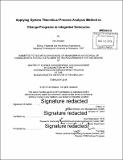| dc.contributor.advisor | Eric Rebentisch. | en_US |
| dc.contributor.author | Tan, Shuijian | en_US |
| dc.contributor.other | System Design and Management Program. | en_US |
| dc.date.accessioned | 2015-12-16T16:34:35Z | |
| dc.date.available | 2015-12-16T16:34:35Z | |
| dc.date.copyright | 2013 | en_US |
| dc.date.issued | 2014 | en_US |
| dc.identifier.uri | http://hdl.handle.net/1721.1/100366 | |
| dc.description | Thesis: S.M. in Engineering and Management, Massachusetts Institute of Technology, Engineering Systems Division, System Design and Management Program, February 2014. | en_US |
| dc.description | Cataloged from PDF version of thesis. | en_US |
| dc.description | Includes bibliographical references (pages 119-123). | en_US |
| dc.description.abstract | Manufacturing and life science enterprises need a flexible and effective approach to respond to industrial compliances and high complexity in stakeholder communication. The paper proposes a system engineering approach in System Theoretical Process Analysis (STPA) as an enterprise transformation method adopted by IT consultancy firms to better define enterprise requirements for transformation and integrate change interventions into organizational structure. Despite STPA being a hazard analysis method, its corresponding hierarchical control structure applies to organizational structures, with adaptations to value x-matrices based on stakeholder value theory and process models necessary to match operators' mental models for control actions and attain information reusability and harmonized processes. Through alignment of the info-logical and socio-cultural aspects of integrated enterprises led by change program management, potential flaws in organizational structures and information systems are identified and proposed for resolution. A qualitative and visual approach using 2 change program cases and lean concept was adopted in this study. Surveys were conducted with program participants, and semi-structured interviews were held with program management to explore perspectives on utilizing the enterprise-adapted STPA. The outcomes are the validation of this method, and lean practice in change interventions as recommendations for integration of processes and enterprise functions and promotion of program flow. Keywords: Enterprise Architecture, System Engineering, Change Management, Program Management, Stakeholder Theory, STPA, Architectural Alignment, Communication, lean. | en_US |
| dc.description.statementofresponsibility | by Tan Shuijian. | en_US |
| dc.format.extent | 146 pages | en_US |
| dc.language.iso | eng | en_US |
| dc.publisher | Massachusetts Institute of Technology | en_US |
| dc.rights | M.I.T. theses are protected by copyright. They may be viewed from this source for any purpose, but reproduction or distribution in any format is prohibited without written permission. See provided URL for inquiries about permission. | en_US |
| dc.rights.uri | http://dspace.mit.edu/handle/1721.1/7582 | en_US |
| dc.subject | Engineering Systems Division. | en_US |
| dc.subject | System Design and Management Program. | en_US |
| dc.title | Applying system theoretical process analysis method to change programs in integrated enterprise | en_US |
| dc.type | Thesis | en_US |
| dc.description.degree | S.M. in Engineering and Management | en_US |
| dc.contributor.department | System Design and Management Program. | en_US |
| dc.contributor.department | Massachusetts Institute of Technology. Engineering Systems Division | |
| dc.identifier.oclc | 931574615 | en_US |
